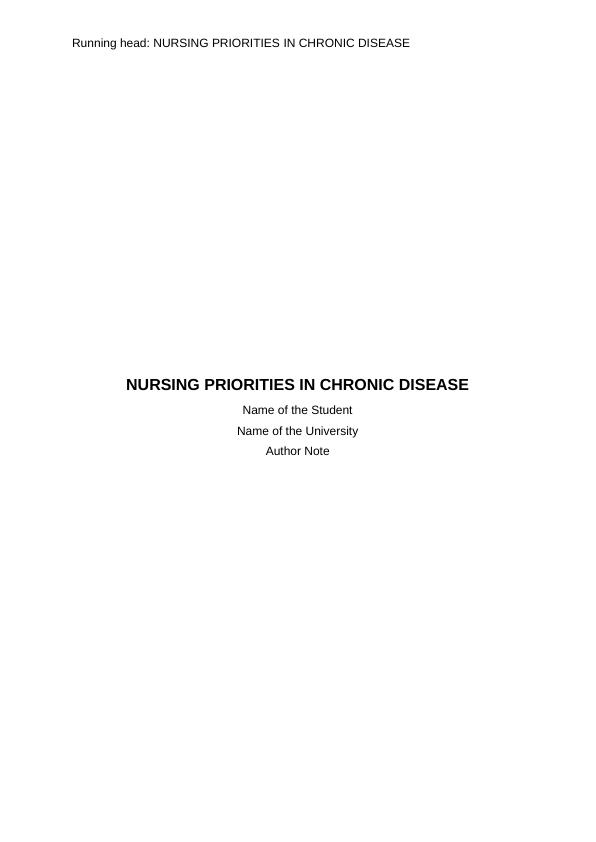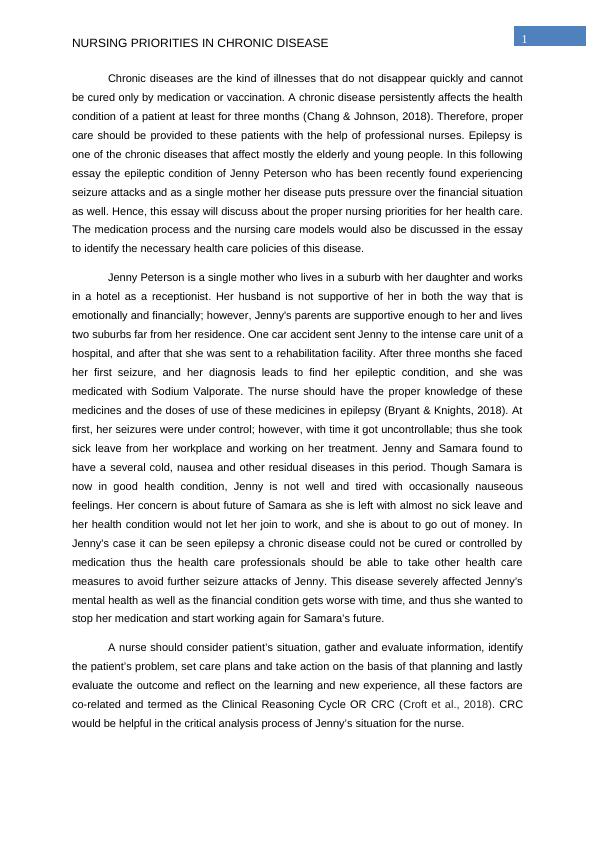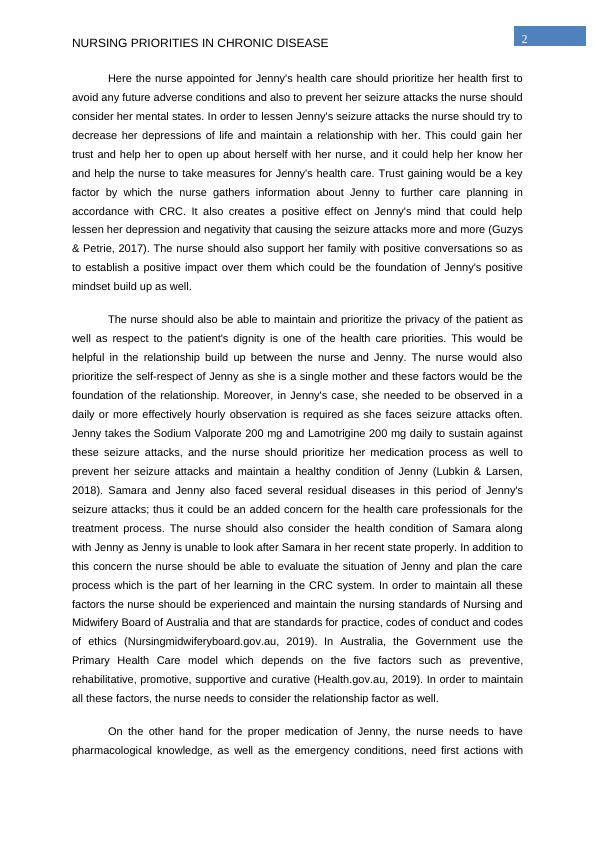Nursing Priorities in Chronic Disease
Added on 2023-04-20
7 Pages2523 Words286 Views
Running head: NURSING PRIORITIES IN CHRONIC DISEASE
NURSING PRIORITIES IN CHRONIC DISEASE
Name of the Student
Name of the University
Author Note
NURSING PRIORITIES IN CHRONIC DISEASE
Name of the Student
Name of the University
Author Note

1NURSING PRIORITIES IN CHRONIC DISEASE
Chronic diseases are the kind of illnesses that do not disappear quickly and cannot
be cured only by medication or vaccination. A chronic disease persistently affects the health
condition of a patient at least for three months (Chang & Johnson, 2018). Therefore, proper
care should be provided to these patients with the help of professional nurses. Epilepsy is
one of the chronic diseases that affect mostly the elderly and young people. In this following
essay the epileptic condition of Jenny Peterson who has been recently found experiencing
seizure attacks and as a single mother her disease puts pressure over the financial situation
as well. Hence, this essay will discuss about the proper nursing priorities for her health care.
The medication process and the nursing care models would also be discussed in the essay
to identify the necessary health care policies of this disease.
Jenny Peterson is a single mother who lives in a suburb with her daughter and works
in a hotel as a receptionist. Her husband is not supportive of her in both the way that is
emotionally and financially; however, Jenny's parents are supportive enough to her and lives
two suburbs far from her residence. One car accident sent Jenny to the intense care unit of a
hospital, and after that she was sent to a rehabilitation facility. After three months she faced
her first seizure, and her diagnosis leads to find her epileptic condition, and she was
medicated with Sodium Valporate. The nurse should have the proper knowledge of these
medicines and the doses of use of these medicines in epilepsy (Bryant & Knights, 2018). At
first, her seizures were under control; however, with time it got uncontrollable; thus she took
sick leave from her workplace and working on her treatment. Jenny and Samara found to
have a several cold, nausea and other residual diseases in this period. Though Samara is
now in good health condition, Jenny is not well and tired with occasionally nauseous
feelings. Her concern is about future of Samara as she is left with almost no sick leave and
her health condition would not let her join to work, and she is about to go out of money. In
Jenny's case it can be seen epilepsy a chronic disease could not be cured or controlled by
medication thus the health care professionals should be able to take other health care
measures to avoid further seizure attacks of Jenny. This disease severely affected Jenny’s
mental health as well as the financial condition gets worse with time, and thus she wanted to
stop her medication and start working again for Samara’s future.
A nurse should consider patient’s situation, gather and evaluate information, identify
the patient’s problem, set care plans and take action on the basis of that planning and lastly
evaluate the outcome and reflect on the learning and new experience, all these factors are
co-related and termed as the Clinical Reasoning Cycle OR CRC (Croft et al., 2018). CRC
would be helpful in the critical analysis process of Jenny’s situation for the nurse.
Chronic diseases are the kind of illnesses that do not disappear quickly and cannot
be cured only by medication or vaccination. A chronic disease persistently affects the health
condition of a patient at least for three months (Chang & Johnson, 2018). Therefore, proper
care should be provided to these patients with the help of professional nurses. Epilepsy is
one of the chronic diseases that affect mostly the elderly and young people. In this following
essay the epileptic condition of Jenny Peterson who has been recently found experiencing
seizure attacks and as a single mother her disease puts pressure over the financial situation
as well. Hence, this essay will discuss about the proper nursing priorities for her health care.
The medication process and the nursing care models would also be discussed in the essay
to identify the necessary health care policies of this disease.
Jenny Peterson is a single mother who lives in a suburb with her daughter and works
in a hotel as a receptionist. Her husband is not supportive of her in both the way that is
emotionally and financially; however, Jenny's parents are supportive enough to her and lives
two suburbs far from her residence. One car accident sent Jenny to the intense care unit of a
hospital, and after that she was sent to a rehabilitation facility. After three months she faced
her first seizure, and her diagnosis leads to find her epileptic condition, and she was
medicated with Sodium Valporate. The nurse should have the proper knowledge of these
medicines and the doses of use of these medicines in epilepsy (Bryant & Knights, 2018). At
first, her seizures were under control; however, with time it got uncontrollable; thus she took
sick leave from her workplace and working on her treatment. Jenny and Samara found to
have a several cold, nausea and other residual diseases in this period. Though Samara is
now in good health condition, Jenny is not well and tired with occasionally nauseous
feelings. Her concern is about future of Samara as she is left with almost no sick leave and
her health condition would not let her join to work, and she is about to go out of money. In
Jenny's case it can be seen epilepsy a chronic disease could not be cured or controlled by
medication thus the health care professionals should be able to take other health care
measures to avoid further seizure attacks of Jenny. This disease severely affected Jenny’s
mental health as well as the financial condition gets worse with time, and thus she wanted to
stop her medication and start working again for Samara’s future.
A nurse should consider patient’s situation, gather and evaluate information, identify
the patient’s problem, set care plans and take action on the basis of that planning and lastly
evaluate the outcome and reflect on the learning and new experience, all these factors are
co-related and termed as the Clinical Reasoning Cycle OR CRC (Croft et al., 2018). CRC
would be helpful in the critical analysis process of Jenny’s situation for the nurse.

2NURSING PRIORITIES IN CHRONIC DISEASE
Here the nurse appointed for Jenny's health care should prioritize her health first to
avoid any future adverse conditions and also to prevent her seizure attacks the nurse should
consider her mental states. In order to lessen Jenny's seizure attacks the nurse should try to
decrease her depressions of life and maintain a relationship with her. This could gain her
trust and help her to open up about herself with her nurse, and it could help her know her
and help the nurse to take measures for Jenny's health care. Trust gaining would be a key
factor by which the nurse gathers information about Jenny to further care planning in
accordance with CRC. It also creates a positive effect on Jenny's mind that could help
lessen her depression and negativity that causing the seizure attacks more and more (Guzys
& Petrie, 2017). The nurse should also support her family with positive conversations so as
to establish a positive impact over them which could be the foundation of Jenny's positive
mindset build up as well.
The nurse should also be able to maintain and prioritize the privacy of the patient as
well as respect to the patient's dignity is one of the health care priorities. This would be
helpful in the relationship build up between the nurse and Jenny. The nurse would also
prioritize the self-respect of Jenny as she is a single mother and these factors would be the
foundation of the relationship. Moreover, in Jenny's case, she needed to be observed in a
daily or more effectively hourly observation is required as she faces seizure attacks often.
Jenny takes the Sodium Valporate 200 mg and Lamotrigine 200 mg daily to sustain against
these seizure attacks, and the nurse should prioritize her medication process as well to
prevent her seizure attacks and maintain a healthy condition of Jenny (Lubkin & Larsen,
2018). Samara and Jenny also faced several residual diseases in this period of Jenny's
seizure attacks; thus it could be an added concern for the health care professionals for the
treatment process. The nurse should also consider the health condition of Samara along
with Jenny as Jenny is unable to look after Samara in her recent state properly. In addition to
this concern the nurse should be able to evaluate the situation of Jenny and plan the care
process which is the part of her learning in the CRC system. In order to maintain all these
factors the nurse should be experienced and maintain the nursing standards of Nursing and
Midwifery Board of Australia and that are standards for practice, codes of conduct and codes
of ethics (Nursingmidwiferyboard.gov.au, 2019). In Australia, the Government use the
Primary Health Care model which depends on the five factors such as preventive,
rehabilitative, promotive, supportive and curative (Health.gov.au, 2019). In order to maintain
all these factors, the nurse needs to consider the relationship factor as well.
On the other hand for the proper medication of Jenny, the nurse needs to have
pharmacological knowledge, as well as the emergency conditions, need first actions with
Here the nurse appointed for Jenny's health care should prioritize her health first to
avoid any future adverse conditions and also to prevent her seizure attacks the nurse should
consider her mental states. In order to lessen Jenny's seizure attacks the nurse should try to
decrease her depressions of life and maintain a relationship with her. This could gain her
trust and help her to open up about herself with her nurse, and it could help her know her
and help the nurse to take measures for Jenny's health care. Trust gaining would be a key
factor by which the nurse gathers information about Jenny to further care planning in
accordance with CRC. It also creates a positive effect on Jenny's mind that could help
lessen her depression and negativity that causing the seizure attacks more and more (Guzys
& Petrie, 2017). The nurse should also support her family with positive conversations so as
to establish a positive impact over them which could be the foundation of Jenny's positive
mindset build up as well.
The nurse should also be able to maintain and prioritize the privacy of the patient as
well as respect to the patient's dignity is one of the health care priorities. This would be
helpful in the relationship build up between the nurse and Jenny. The nurse would also
prioritize the self-respect of Jenny as she is a single mother and these factors would be the
foundation of the relationship. Moreover, in Jenny's case, she needed to be observed in a
daily or more effectively hourly observation is required as she faces seizure attacks often.
Jenny takes the Sodium Valporate 200 mg and Lamotrigine 200 mg daily to sustain against
these seizure attacks, and the nurse should prioritize her medication process as well to
prevent her seizure attacks and maintain a healthy condition of Jenny (Lubkin & Larsen,
2018). Samara and Jenny also faced several residual diseases in this period of Jenny's
seizure attacks; thus it could be an added concern for the health care professionals for the
treatment process. The nurse should also consider the health condition of Samara along
with Jenny as Jenny is unable to look after Samara in her recent state properly. In addition to
this concern the nurse should be able to evaluate the situation of Jenny and plan the care
process which is the part of her learning in the CRC system. In order to maintain all these
factors the nurse should be experienced and maintain the nursing standards of Nursing and
Midwifery Board of Australia and that are standards for practice, codes of conduct and codes
of ethics (Nursingmidwiferyboard.gov.au, 2019). In Australia, the Government use the
Primary Health Care model which depends on the five factors such as preventive,
rehabilitative, promotive, supportive and curative (Health.gov.au, 2019). In order to maintain
all these factors, the nurse needs to consider the relationship factor as well.
On the other hand for the proper medication of Jenny, the nurse needs to have
pharmacological knowledge, as well as the emergency conditions, need first actions with

End of preview
Want to access all the pages? Upload your documents or become a member.
Related Documents
The Role of a Primary Health Care Nurse in Managing Epilepsy: A Case Studylg...
|6
|2274
|76
Managing Epilepsy: A Case Study of Jenny Petersonlg...
|9
|2433
|338
Case Study Analysis: Jenny Petersonlg...
|7
|2201
|112
Assessment of Patient Jenny Peterson: Maintaining a Safe Environment and Deficient Knowledge on Seizure Managementlg...
|6
|2184
|439
Generalized Tonic-Clonic Seizure - A Case Studylg...
|7
|2242
|35
Nrsg 366 Partnerships in Chronicitylg...
|7
|2373
|54
